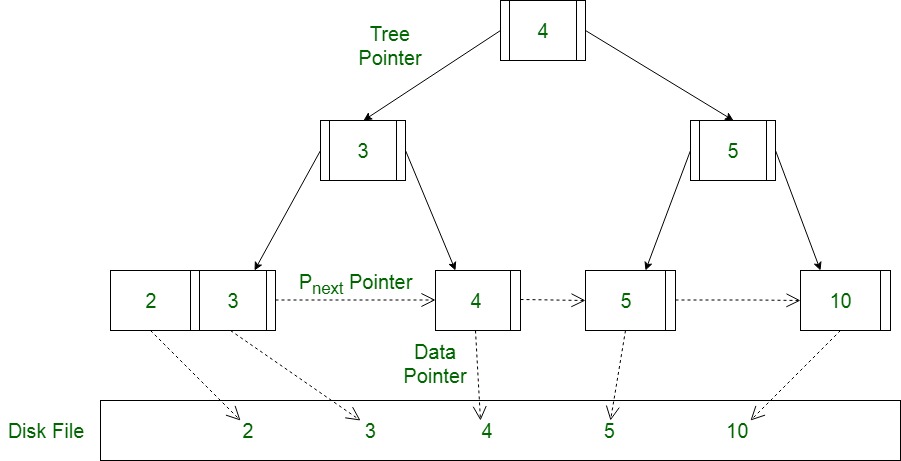What is B+ Tree | B+ Tree meaning
Last Updated :
02 Mar, 2023
The B+ tree is similar to the B-tree data structure in that it is a tree structure with a fixed number of keys per node, and it is balanced so that all leaf nodes are at the same level. However, in a B+ tree, all keys are stored in the leaf nodes, while the internal nodes only contain pointers to other nodes.

B+ Tree example
Characteristics of B+ Tree:
The characteristics of a B+ tree are as follows:
- Balanced: Like a B-tree, a B+ tree is a balanced tree structure, which means that all leaf nodes are at the same level. This ensures that the time required to access data in the tree remains constant, regardless of the size of the data set.
- Multiple keys per node: B+ tree allows for multiple keys to be stored in each node. This allows for efficient use of memory and reduces the height of the tree.
- Ordered: A B+ tree maintains the order of the keys, which makes searching and range queries efficient.
- All keys are stored in leaf nodes: In a B+ tree, all keys are stored in the leaf nodes, while the internal nodes only contain pointers to other nodes.
- Internal nodes have a higher fanout: Because the internal nodes only contain pointers to other nodes, they can have a higher fanout than in a B-tree. This allows for more efficient use of memory and faster data retrieval.
Applications of B+ Tree:
- Database indexing: B+ trees are commonly used to index large databases. The keys in the B+ tree are the values in the indexed column of the database table, and the leaf nodes of the B+ tree contain pointers to the actual data rows in the table.
- File systems: B+ trees are used in file systems to organize and store large numbers of files. The keys in the B+ tree are the names of the files, and the leaf nodes contain pointers to the actual file data.
- Operating systems: B+ trees are used in operating systems to manage virtual memory. The keys in the B+ tree are the page numbers, and the leaf nodes contain pointers to the actual physical memory pages.
- Networking: B+ trees are used in networking to store and retrieve routing information. The keys in the B+ tree are the network addresses, and the leaf nodes contain information about the routing paths.
Difference between B tree and B+ Tree:
| Feature |
B Tree |
B+ Tree |
| Internal node keys |
Store keys and pointers to child nodes |
Store only keys, no data |
| Leaf node keys |
Store keys and data |
Store only keys and pointers to data |
| Leaf node linking |
Not required |
Linked together in a linked list |
| Height of tree |
Taller due to data in internal nodes |
Shorter due to only keys being in internal nodes |
| Memory utilization |
Less efficient due to data in internal nodes |
More efficient due to only keys being in internal nodes |
| Data retrieval |
Slower due to more disk accesses required to reach data |
Faster due to fewer disk accesses required to reach data |
For learning more about the difference between the two refer to this article.
Advantages of B+ Tree:
- Faster data retrieval: Because B+ trees have a higher fanout and store only keys in internal nodes, they require fewer disk accesses to retrieve data. This makes B+ trees faster than other data structures for retrieving data, especially when dealing with large datasets.
- Support for range queries: B+ trees are designed to support range queries, which means that they can quickly retrieve a range of data from the tree. This is especially useful in database applications where queries often involve retrieving a range of values.
- Sequential access is efficient: B+ trees are designed to allow sequential access to the data stored in the tree. This is because the leaf nodes of a B+ tree are linked together in a linked list, which allows for efficient sequential access to the data.
- Balanced structure: Like B-trees, B+ trees are a balanced tree structure. This means that all leaf nodes are at the same level, which ensures that the time required to access data in the tree remains constant, regardless of the size of the data set.
Disadvantages of B+ Tree:
- Complex implementation: B+ trees are more complex to implement than simpler data structures like arrays or linked lists. This can make them more difficult to understand and maintain.
- Slower inserts and deletes: Inserting or deleting data from a B+ tree can be slower than other data structures, as it requires restructuring the tree to maintain its balance.
- Higher memory overhead: While B+ trees are efficient in terms of memory usage, they still have a higher memory overhead than simpler data structures like arrays or linked lists.
- Limited use cases: B+ trees are designed for storing and retrieving large amounts of data, and are best suited for applications like databases and file systems. They may not be the best choice for smaller data sets or applications where sequential access is not important.
What else can you read?
Share your thoughts in the comments
Please Login to comment...